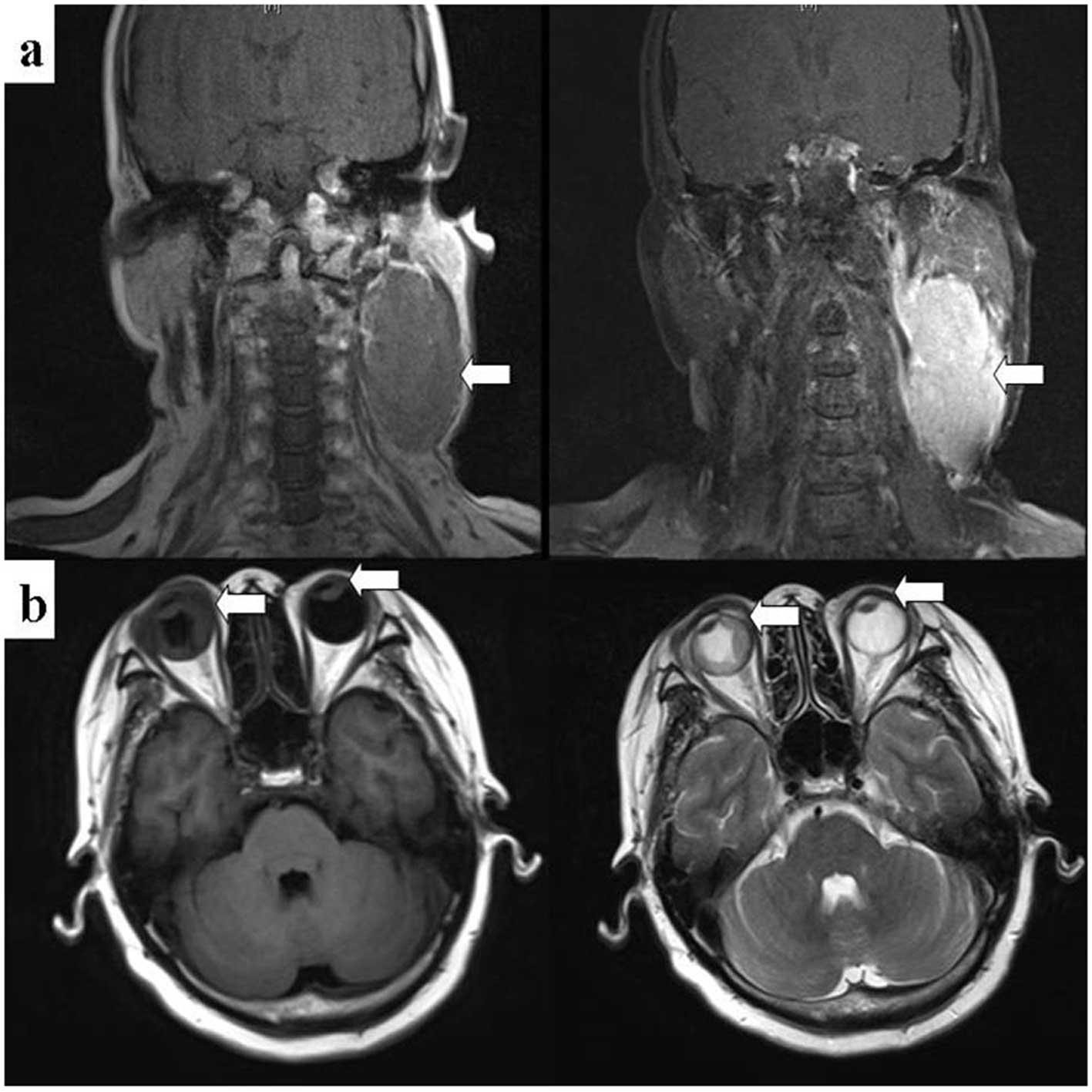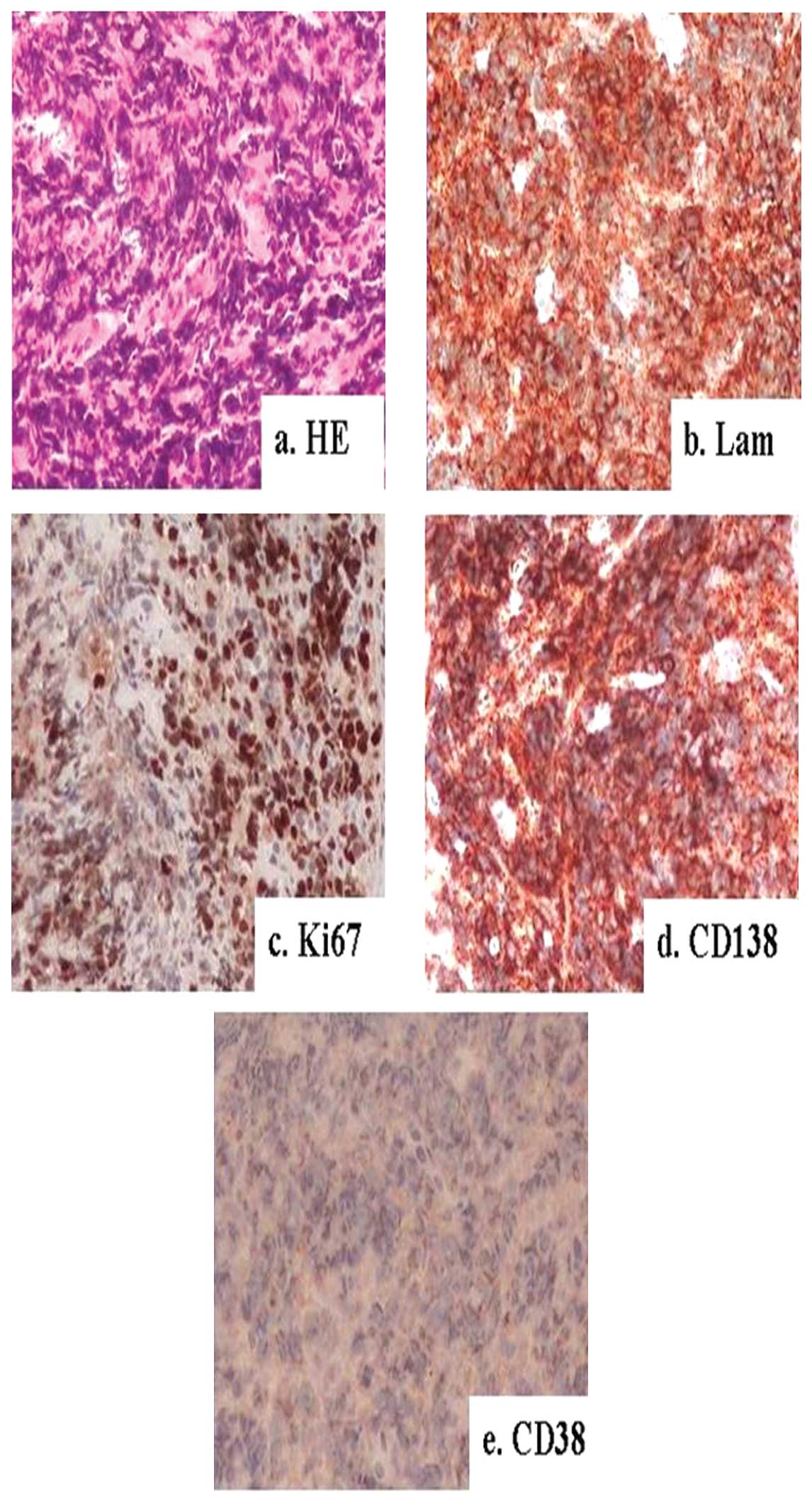Multiple myeloma with extramedullary plasmacytoma invading the skin and eyeballs following autologous stem cell transplantation: A case report
- Authors:
- Guangzhong Yang
- Chuanying Geng
- Yanchen Li
- Aijun Liu
- Wenming Chen
-
View Affiliations
Affiliations: Department of Hematology and Multiple Myeloma Research Center of Beijing, Beijing Chaoyang Hospital, Capital Medical University, Beijing 100020, P.R. China
- Published online on: August 5, 2013 https://doi.org/10.3892/etm.2013.1246
-
Pages:
883-886
Metrics:
Total
Views: 0 (Spandidos Publications: | PMC Statistics:
)
Metrics:
Total PDF Downloads: 0 (Spandidos Publications: | PMC Statistics:
)
This article is mentioned in:
Abstract
In this study, the case of a 60-year-old female patient who presented with a subcutaneous mass in the lower right limb is described. The mass was confirmed as a plasmacytoma. The patient was diagnosed with multiple myeloma (MM) λ type stage III international stage system (ISS) and received three cycles of a therapeutic PDT regimen (bortezomib, dexamethasone and thalidomide) and complete remission was achieved. Following a further two cycles of the PDT regimen, the patient proceeded to received a high-dose cyclophosphamide regimen combined with granulocyte-colony stimulating factor (G-CSF) for stem cell mobilization. Fourteen months later, the patient received a high-dose therapy supported by autologous stem cell transplantation (auto-SCT). After six months, a subcutaneous mass was identified in the left side of the patient's neck and the mass gradually increased in size. The patient exhibited exophthalmos and loss of sight one month later. The masses in the neck and right eyelid of the patient were diagnosed as plasmacytomas. These results, combined with the results of bone marrow (BM) aspiration and protein electrophoresis with immunofixation electrophoresis revealed that the disease had relapsed. The patient received two cycles of a therapeutic CPADT regimen (cyclophosphamide, bortezomib, pharmorubicin, dexamethasone and thalidomide). The patient subsequently achieved complete remission again. The patient refused to continue receiving bortezomib and pharmorubicin for therapy and instead received four cycles of the therapeutic CTD regimen (cyclophosphamide, dexamethasone and thalidomide). Subsequently the patient received local radiotherapy for the masses in the eyes and neck. The patient remained stable after treatment following the initial relapse with a progression-free survival (PFS) time of eight months.
View References
|
1.
|
Lorsbach RB, Hsi ED, Dogan A and Fend F:
Plasma cell myeloma and related neoplasms. Am J Clin Pathol.
136:168–182. 2011. View Article : Google Scholar : PubMed/NCBI
|
|
2.
|
Varettoni M, Corso A, Pica G,
Mangiacavalli S, Pascutto C and Lazzarino M: Incidence, presenting
features and outcome of extramedullary disease in multiple myeloma:
a longitudinal study on 1003 consecutive patients. Ann Oncol.
21:325–330. 2010. View Article : Google Scholar : PubMed/NCBI
|
|
3.
|
Greipp PR, San Miguel J, Durie BG, et al:
International staging system for multiple myeloma. J Clin Oncol.
23:3412–3420. 2005. View Article : Google Scholar : PubMed/NCBI
|
|
4.
|
Zeiser R, Deschler B, Bertz H, et al:
Extramedullary vs medullary relapse after autologous or allogeneic
hematopoietic stem cell transplantation (HSCT) in multiple myeloma
(MM) and its correlation to clinical outcome. Bone Marrow
Transplant. 34:1057–1065. 2004. View Article : Google Scholar : PubMed/NCBI
|
|
5.
|
Terpos E, Rezvani K, Basu S, et al:
Plasmacytoma relapses in the absence of systemic progression
post-high-dose therapy for multiple myeloma. Eur J Haematol.
75:376–383. 2005. View Article : Google Scholar : PubMed/NCBI
|
|
6.
|
Perez-Simon JA, Sureda A, Fernandez-Aviles
F, et al: Reduced-intensity conditioning allogeneic transplantation
is associated with a high-incidence of extramedullary relapses in
multiple myeloma patients. Leukemia. 20:542–545. 2006.
|
|
7.
|
Dawson MA, Patil S and Spencer A:
Extramedullary relapse of multiple myeloma associated with a shift
in secretion from intact immunoglobulin to light chains.
Haematologica. 92:143–144. 2007. View Article : Google Scholar : PubMed/NCBI
|
|
8.
|
Rajkumar SV, Blood E, Vesole D, et al
Eastern Cooperative Oncology Group: Phase III clinical trial of
thalidomide plus dexamethasone compared with dexamethasone alone in
newly diagnosed multiple myeloma: a clinical trial coordinated by
the Eastern Cooperative Oncology Group. J Clin Oncol. 24:431–436.
2006. View Article : Google Scholar
|
|
9.
|
Richardson PG, Sonneveld P, Schuster MW,
et al: Bortezomib or high-dose dexamethasone for relapsed multiple
myeloma. N Engl J Med. 352:2487–2498. 2005. View Article : Google Scholar : PubMed/NCBI
|
|
10.
|
Weber DM, Chen C, Niesvizky R, et al:
Lenalidomide plus dexamethasone for relapsed multiple myeloma in
North America. N Engl J Med. 357:2133–2142. 2007. View Article : Google Scholar : PubMed/NCBI
|
|
11.
|
Laura R, Cibeira MT, Uriburu C, et al:
Bortezomib: an effective agent in extramedullary disease in
multiple myeloma. Eur J Haematol. 76:405–408. 2006. View Article : Google Scholar : PubMed/NCBI
|
|
12.
|
Patriarca F, Prosdocimo S, Tomadini V, et
al: Efficacy of bortezomib therapy for extramedullary relapse of
myeloma after autologous and non-myeloablative allogeneic
transplantation. Haematologica. 90:278–279. 2005.PubMed/NCBI
|
|
13.
|
Damaj G, Mohty M, Vey N, et al: Features
of extramedullary and extraosseous multiple myeloma: a report of 19
patients from a single center. Eur J Haematol. 73:402–406. 2004.
View Article : Google Scholar : PubMed/NCBI
|













